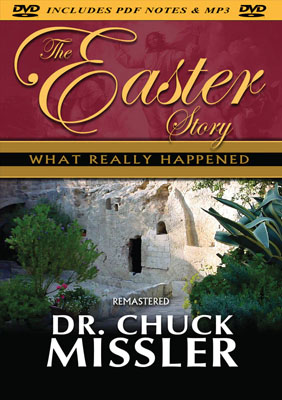Every spring, we celebrate the death and resurrection of Jesus Christ by hiding colored eggs and chocolate bunnies for our children. Little girls run around in white frilly dresses and boys sport handsome braces to hold up well-pressed trousers. It's nice to attend church Easter morning wearing our new best clothes.
Most of us are aware that the celebration of Christ's resurrection has nothing to do with fluffy chicks and bunnies, and this book is not a lecture about ancient spring fertility religions. Many people are even aware that the word “Easter” comes from the name of a fertility goddess, the famous Ishtar of Babylonian fame. There are other misconceptions about our third favorite sugar-coma holiday, misconceptions that I want to consider and unravel.
When we celebrate “Easter” in our culture, we are no longer offering sacrifices to Ishtar. It's the term we use to refer to the Christian holiday that derived from the Jewish Passover. We are celebrating the atoning death and resurrection of Jesus Christ, the Savior of the world. It's astonishing to discover that much of what we've been taught about Easter are misconceptions. Some of them very deliberate misconceptions, and I want to get into the background of some of these myths and misunderstandings that plague the Easter story. What really happened that day in Judea two millennia ago?
Mel Gibson did a phenomenal job in his effort to reproduce the brutal abuse that Jesus Christ suffered that fateful morning. Despite some artistic license, The Passion of the Christ is a very moving cinematic portrayal of Christ's crucifixion, and Jesus did suffer enormously at the hands of the Roman soldiers. However, I think the film has a major shortcoming; it creates the impression that the crucifixion was a tragedy. That is one of the big misconceptions about the death of Jesus Christ — that it was a tragedy. Certainly, those standing at the foot of the cross that day felt the battle had just been lost. Their Lord, Master and Friend was being slaughtered, and all their dreams of His conquering Rome and setting up His kingdom were smashed to bits. However, our Lord's death wasn't a tragedy. It was the greatest achievement of all time. It was a massive triumph, and that victory was completed three days later when Jesus rose from the dead as the Conqueror over sin and death.
We need to recognize that Christ's death was not an accident or an afterthought. Its specifications were laid down before the foundation of the world. It was the climax of a mission. Jesus came to earth to undo the damage done by Adam, to cancel the curse and buy back our lives from destruction.
The second shortcoming of Gibson's movie is that it doesn't get across who Jesus really is. It assumes the audience already knows, so it doesn't bring full attention to the true identity of Jesus. The Creator Himself became incarnate to die on our behalf.
Those are two critical issues that we must confront, the death of Christ was an achievement planned from the beginning of the world, and the Creator Himself died on that cross.
There's another misconception about the Easter story that is shared by most of the Christian world. The death and resurrection of Jesus fulfilled a multitude of Old Testament prophecies and should be celebrated in conjunction with three Jewish celebrations: the Feasts of Passover, Unleavened Bread, and First fruits. In the fourth century AD, after Constantine became emperor of Rome, there were still Christians who wanted to celebrate the Resurrection of our Lord in connection to Passover. Jesus had died on Passover and was raised again on the Feast of First fruits. These men were called “Quartodecimans” because they wanted to celebrate the Passover on the 14th of Nisan, according to the Jewish calendar.
The Latin word Quartodeciman means “14th” or “14th people.” In the first, second, and third centuries, the Christians celebrated the death of Jesus on the Passover and His resurrection three days later. They clung to the Torah specifications of Passover, which was given as an everlasting feast, a perpetual ordinance.
We discover that contentions started brewing in the Roman church in AD 115 to 125, because the Roman church celebrated Passover on Sunday, not on Nisan 14. Eusebius records that in AD 154, Polycarp visited Rome to discuss the difference in Passover calculation with Bishop Anisettes and they reached an amicable compromise. Polycrates of Ephesus and Irenaeus wrote in support of the Quartodecimans.1
However, by the time of the Council of Nicaea in AD 325, the Quartodecimans were considered an oddity. It was officially decided that Christians should not celebrate the Lord's death and resurrection in conjunction with Passover, and the council arranged it so that Easter would never be celebrated on Passover. It unanimously ruled that the Easter festival should be celebrated throughout the Christian world on the first Sunday after the first full moon following the vernal equinox. What's more, if the full moon should occur on a Sunday and thereby coincide with the Passover festival, Easter should be commemorated on the following Sunday. They sought to deliberately worship on a day other than what was ordained in the Bible.
The Quartodecimans were not given a choice in the matter. They were excommunicated if they persisted in what was seen as a Jewish error. Antisemitism had crept into the church with such fervor that the church under Rome attempted to eradicate any vestiges of Judaism from the teachings of Christianity. As result of the Council of Nicaea, the formal church desperately attempted to design a formula for Easter, as they called it, which would avoid the possibility of falling on the Jewish Passover, even accidentally. Those that wanted Christianity to remain based in the Old Testament became outcasts. In his Life of Constantine, the Christian historian Eusebius quoted Constantine as saying:
[I]t appeared an unworthy thing that in the celebration of this most holy feast we should follow the practice of the Jews, who have impiously defiled their hands with enormous sin, and are, therefore, deservedly afflicted with blindness of soul. ... Let us then have nothing in common with the detestable Jewish crowd; for we have received from our Savior a different way.
In the epistle of Emperor Constantine to the bishops after the Council of Nicaea, Constantine wrote heatedly against celebrating Easter in conjunction with the Jewish celebration of Passover, saying:
Let us, then, have nothing in common with the Jews, who are our adversaries. For we have received from our Savior another way. A better and more lawful line of conduct is inculcated by our holy religion. Let us with one accord walk therein, my much-honored brethren, studiously avoiding all contact with that evil way. They boast that without their instructions we should be unable to commemorate the festival properly. This is the highest pitch of absurdity. For how can they entertain right views on any point who, after having compassed the death of the Lord, being out of their minds, are guided not by sound reason, but by an unrestrained passion, wherever their innate madness carries them...Therefore, this irregularity must be corrected, in order that we may no more have any thing in common with those parricides and the murderers of our Lord... that it is most pious that all should unanimously agree in that course which accurate reasoning seems to demand, and which has no single point in common with the perjury of the Jews.2
That is shocking language. We need to realize that the early church became so anti-Semitic that they altered their practices away from the biblical text and ushered in all kinds of confusion. That confusion still reigns today, which is why we need to sift through some of our Easter traditions.
To top it all, the Roman church was under the Julian calendar, which had an astronomical problem; there was a discrepancy between the solar and lunar year. The lunar calendar drives the Jewish calendar. Numerous alternatives for fixing the date of Easter were tried by the church, but proved unsatisfactory, which resulted in different dates for Easter celebrations throughout the Christian world. In AD 387, the dates of Easter in France and Egypt were separated by 35 days. Utter confusion was reigning.
About AD 465, the church adopted a system of calculation proposed by the astronomer Victorinus to reform the calendar and fixed the date of Easter. Some of his methods are still in use, although the Scythian monk Dionysius Exiguus made significant adjustments to the Easter cycle in the sixth century. Refusal by the British and Celtic Christian churches to adopt the proposed changes lead to a bitter dispute between them and Rome in the seventh century.
The Julian calendar was finally reformed in 1582 under Pope Gregory XIII. This eliminated some of the difficulties in fixing the date of Easter and arranging the ecclesiastical year, but it was not accepted for two centuries by Great Britain and Ireland. Easter was finally celebrated on the same day in the Western part of the Christian world after 1752.
The Eastern churches, however, never did adopt the Gregorian calendar, and they commemorate Easter on the Sunday either preceding or following the date observed in the West. Occasionally the dates coincide by coincidence, such as in 1865 and 1963. In 1928, the British Parliament enacted a measure allowing the Church of England to commemorate Easter on the first Sunday after the second Saturday in April. Thus, Easter is still considered a “moveable” feast day.
All this trouble, and the formulas, were unnecessary in the first place. They were designed simply to avoid celebrating the feast at the time of the Jewish Passover. This is the height of senselessness, because Jesus was put to death on Passover. In fact, He was executed on Passover by God's very specific design, in fulfillment of the Scriptures.
Jesus knew that He was the fulfillment of prophecies that filled the Old Testament. In Revelation 13:8, John calls Jesus “the Lamb slain from the foundation of the world.” The God who is outside of time itself knew long before Adam and Even sinned that He would send His Son, God incarnate, into the world to hang on a cross in our place and pay for our sins. From the beginning of Genesis, God foretold this would happen. He set up feasts to help explain it to the Jewish people. He offered types and examples all through the Old Testament, “here a little, there a little,” as prophesied in Isaiah 28:9-13. We see that Jesus Christ is written constantly on every page of the Hebrew Scriptures.
God told the Jewish people in advance what He would do to save the world, but they didn't understand. Jesus' own disciples didn't get it. Even when He told them plainly, using straight forward Aramaic, they didn't comprehend that He was going to die:
And it came to pass, when Jesus had finished all these sayings, he said unto his disciples, Ye know that after two days is the feast of the passover, and the Son of man is betrayed to be crucified.
Matthew 26:1-2
The whole sacrificial system had been set up so the Jews, and the rest of the world through them, could understand that a sacrifice had to be made to pay for sin. Blood had to be spilled. Jesus had come to fulfill, not just a few verses, but the whole sacrificial system of the Law. John the Baptist got it, and when he introduced Jesus to the world, he did not cry out, “Here is the Messiah!” No, what did he say in John 1:29? He said, “Behold the Lamb of God, which taketh away the sin of the world.”
From the beginning of His ministry, the disciples should have recognized the role of Jesus as the sacrificial Lamb, because John had declared that role for Him right then — right there at the start.
Isaac
Back in Genesis 22, we read about the Akedah, the binding of Isaac. God ordered Abraham to go and sacrifice Isaac, his beloved son, his “only son” on a mountain in the land of Moriah. Abraham did not argue or question. He simply went out and cut wood and got the donkey ready, and he headed out. After three days, he saw the place ahead, and he left his two servants behind and went on ahead alone with Isaac. Isaac was understandably puzzled about the arrangement, and he asks his father a question.
And Isaac spake unto Abraham his father, and said, My father: and he said, Here am I, my son. And he said, Behold the fire and the wood: but where is the lamb for a burnt offering? And Abraham said, My son, God will provide himself a lamb for a burnt offering: so they went both of them together.
Genesis 22:7-8
Abraham bound Isaac and got ready to slay him when God intervened and stopped him. The Lord didn't allow Abraham to go through with it, of course, and He provided a ram in Isaac's place.
Throughout the Old Testament, God consistently condemns child sacrifice. The people had a habit of falling into the pagan practices of the Canaanites, which included sacrificing their children in the fire to the god Molech. Abraham, however, didn't believe he was truly losing his son. God had promised him that Isaac would become the father of nations and kings in Genesis 17:16-19, which meant that Isaac had to live. It's the writer of Hebrews who explains to us that Abraham believed God would raise Isaac from the dead.
By faith Abraham, when he was tried, offered up Isaac: and he that had received the promises offered up his only begotten son, Of whom it was said, That in Isaac shall thy seed be called: Accounting that God was able to raise him up, even from the dead; from whence also he received him in a figure.
Hebrews 11:17-19
Abraham knew he was acting out prophecy, because he named the place Jehovah Jireh. As Genesis 22:14 explains, “And Abraham called the name of that place Jehovahjireh: as it is said to this day, In the mount of the LORD it shall be seen.” There is a song that goes, “Jehovah Jireh, my provider, His grace is sufficient for me.” It's a good song, but Jehovah Jireh does not mean “the LORD provides.” It means, “the LORD will see.” God would see this take place.
Indeed, the act that Abraham played out was truly seen two millennia later when the Lamb of God was made the eternal sacrifice in our place. Two thousand years later, a Father would sacrifice His beloved Son, His only Son, on Mt. Moriah, and I believe Jesus Christ died in the exact spot where God had directed Abraham to sacrifice Isaac.
As we begin to study the Scripture, we quickly discover that every detail there is a thread in an elegantly designed tapestry, and two major pictures are portrayed in it. The first is Christ's sacrifice, and the second is Christ's eternal victory and reign as King.
Lifted Up and Pierced
The manner in which Jesus dies is actually very unusual from a Jewish perspective. Jesus was accused of blasphemy by the Jews, and according to Leviticus 24:10-16, the punishment for blasphemy was stoning. However, we notice that every time the Jews tried to stone Jesus, He just walked out from among them.3
Jesus knew He was going to be crucified. In John 3, He likens Himself to the fiery brazen serpent that Moses made and put on a pole. The word for “pole” here is better translated “standard” or “flagstaff” — which means it had a crossbar on it; and it would have been about 10 feet tall, and Moses made a brass serpent and attached it to this flagstaff. It was a bronze serpent hanging on a cross. All who looked at that brass serpent were healed, and all who look to Jesus are healed. This is what Jesus explains to Nicodemus in John 3:
And as Moses lifted up the serpent in the wilderness, even so must the Son of man be lifted up: That whosoever believeth in him should not perish, but have eternal life.
John 3:14-15
Why a serpent? Because Jesus would become sin for us, that we could become righteous, as Paul says in 2 Corinthians 5:21. The Messiah would be lifted up. He would take on Himself all the sin of the world, and those who trust in Him are saved.
We also find in the Scriptures that Jesus would be pierced. In Psalm 22, we see a prophetic view of Jesus as He hangs on the cross. It's written from His point of view, and we see the events of the crucifixion play out — in a psalm written by David 1000 years before Jesus was born. In Psalm 22:16, it says, “For dogs have compassed me: the assembly of the
wicked have inclosed me: they pierced my hands and my feet.” The root word for “pierced” here is ari or “lion.” They didn't just stab his hands and feet. They pounded big metal spikes through them, like lion's teeth.
Zechariah 12:10 speaks of a time in the future, when the inhabitants of Jerusalem will see their Messiah and grieve, saying, “and they shall look upon me whom they have pierced, and they shall mourn for him, as one mourneth for his only son” The word for “pierced” here is daqar, which means “stabbed” — referring to the spear in His side.
Jesus knew that He would be crucified, and He repeatedly said so.4 He knew He would be scourged and killed and that He would rise again the third day, and He repeatedly said so.5 The disciples were grief-stricken after His death, fearful and hiding away. He had repeatedly explained to them in advance what was going to happen, and it didn't make sense to them. They didn't understand. Yet, on the road to Emmaus, He tells the two disciples that it was all written in advance in the Law and the Prophets.
Then he said unto them, O fools, and slow of heart to believe all that the prophets have spoken: Ought not Christ to have suffered these things, and to enter into his glory? And beginning at Moses and all the prophets, he expounded unto them in all the scriptures the things concerning himself.
Luke 24:25-27
Jesus was the One in charge that Passover day, the day of His death. He died because that was His mission. That is what He had come to do, and it was the greatest victory, the greatest achievement of all history.
A Man Forever
There's another aspect to Christ's sacrifice that we might not appreciate. John 1 tells us that Jesus was in the beginning with God, and nothing was created without Him. Colossians tells us that all things were created by Him and for Him:
For by him were all things created, that are in heaven, and that are in earth, visible and invisible, whether they be thrones, or dominions, or principalities, or powers: all things were created by him, and for him:
Colossians 1:16
Jesus is the Creator. He is the King of the Universe. He had to completely humble Himself to be made into a little human baby and die on a Roman cross so that we might live. Yet, there's an aspect to this we might not appreciate. When Jesus became flesh, He remained a man. He didn't just transform into a man for 33 1/2 years. He remained a man forever. There is a human being sitting on the throne of God as we speak, and I think we will spend eternity learning to comprehend the enormity of the sacrifice that Jesus made on our behalf.
Why did Jesus do that? Why did He agree to come here, taking our form in order to heal, and feed, and teach His fellow humans until the day they tore Him to shreds? Why did He do that?
We get the answer when Jesus goes out into the Garden of Gethsemane to pray. He walks a little distance from His men and falls on His face, pouring out His heart to the Father. He is so overwhelmed by emotional agony. Dr. Luke relates to us that He begins sweating blood.6 Three times Jesus begs the Father, “O my Father, if it be possible, let this cup pass from me: nevertheless not as I will, but as thou wilt.”7
Why did He go through with it? Because it was the only way for us to be rescued, for us to be saved from eternal punishment. He did it because there was no other way. If there was any other way, then Christ died for no reason. But, because there was no other way, God the Father allowed His Son to be cruelly mocked, and battered, and torn and killed that Passover. That was His mission. It was the very purpose for which He became one of us.
This is an excerpt from Chuck Missler's book The Easter Story: What Really Happened.
Available now from https://store.khouse.org
Notes:
1 Eusebius, History of the Church, 5.24.17.
2 Emperor Constantine, “The Epistle of the Emperor Constantine, concerning the matters transacted at the Council, addressed to those Bishops who were not present” in The Ecclesiastical History of Theodoret, I.IX.
3 John 8:59, 10:31-39
4 Matthew 10:38, 16:24, 26:2; Mark 8:34, 10:21; Luke 14:27, 24:7; John 8:28, 12:32-34
5 Matthew 16:21, 17:23, 20:19, 27:63-64; Mark 9:31, 10:34; Luke 9:22, 13:32, 18:33
6 Luke 22:44
7 Matthew 26:39






